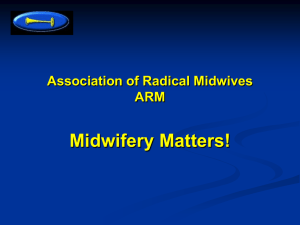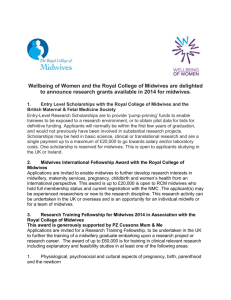International Confederation of Midwives
advertisement
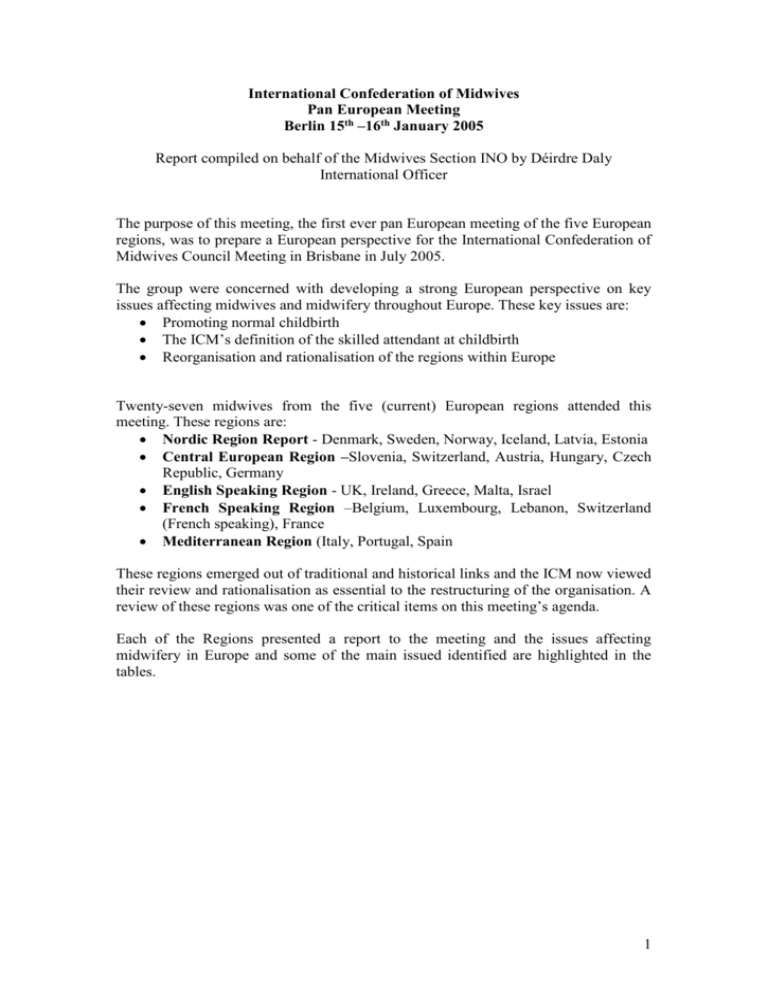
International Confederation of Midwives Pan European Meeting Berlin 15th –16th January 2005 Report compiled on behalf of the Midwives Section INO by Déirdre Daly International Officer The purpose of this meeting, the first ever pan European meeting of the five European regions, was to prepare a European perspective for the International Confederation of Midwives Council Meeting in Brisbane in July 2005. The group were concerned with developing a strong European perspective on key issues affecting midwives and midwifery throughout Europe. These key issues are: Promoting normal childbirth The ICM’s definition of the skilled attendant at childbirth Reorganisation and rationalisation of the regions within Europe Twenty-seven midwives from the five (current) European regions attended this meeting. These regions are: Nordic Region Report - Denmark, Sweden, Norway, Iceland, Latvia, Estonia Central European Region –Slovenia, Switzerland, Austria, Hungary, Czech Republic, Germany English Speaking Region - UK, Ireland, Greece, Malta, Israel French Speaking Region –Belgium, Luxembourg, Lebanon, Switzerland (French speaking), France Mediterranean Region (Italy, Portugal, Spain These regions emerged out of traditional and historical links and the ICM now viewed their review and rationalisation as essential to the restructuring of the organisation. A review of these regions was one of the critical items on this meeting’s agenda. Each of the Regions presented a report to the meeting and the issues affecting midwifery in Europe and some of the main issued identified are highlighted in the tables. 1 International Confederation of Midwives: Synopsis of European Regional Reports Central European Region Nordic Region Report (Slovenia, Switzerland, Austria, Hungary, Czech Republic, Germany ) (Denmark, Sweden, Norway, Iceland, Latvia, Estonia) The main areas of concerns are: The medicalisation of childbirth and the rising caesarean section rates The issue of real versus guided choice for women The provision of antenatal care by midwives in the Nordic countries (some midwives having a high input (Sweden) and others low (Finland) into women’s care. The strengths of private and public provision. The struggle by Latvian and Estonian midwives for recognition and implementation of EU Directives The current concerns of the region are: To raise public awareness of midwifery care To strengthen midwifery as an autonomous profession by promoting independent education programmes To work in partnership with women to achieve good outcomes in birth and parenting. Negotiations with Health Insurance companies regarding midwifery care provision. French Speaking Region English Speaking Region (Belgium, Luxembourg, Lebanon, Switzerland (French speaking), France) (UK, Ireland, Greece, Malta, Israel) The main issues reported are: The current issues affecting the region are: The region met in Dublin, Ireland in October 2004. Belgian midwives are still lobbying for independence from nursing organisations The rising caesarean section rates Switzerland is aiming for more tertiary education The limited Childbirth Choices for women in many countries A letter signed by the Regional Representative on behalf of the English-speaking region, raising questions about direct-entry education provision and the law regulating midwives in Ireland and offering support, was sent to key influential people in the Republic of Ireland (including the Táiniste and Minister for Health & Children). A yahoo email discussion group has been established Mediterranean Region (Italy, Portugal, Spain) The main issues reported are: Italy has introduced a Masters degree in midwifery Portugal is working with Government negotiating direct entry midwifery education Spain has created a new federation named the Association of Spanish Midwives. Negotiations with Government for direct entry midwifery programmes are ongoing All three countries are in a similar situation with regard to rising caesarean section rates, the medicalisation of childbirth but there is an increasing interest in natural birth. 2 These reports were followed by a passionate plea from Zuzana Stromerova from the Czech Republic for help and support in strengthening midwifery and in regaining midwifery skills in order to protect and promote normal birth. Zuzana talked about the demise of midwifery and the increasing reliance on technology in the Czech Republic. Zuzana cited the impact of weak midwifery associations, the negative effect of inter and intra professional disagreements, and the concerns that midwife educators had lost the skills to teach in “traditional, normal/basic midwifery care” as all contributing to the demise of midwifery and a growing reliance on technology. Zuzana suggested that this was a problem that existed across the whole of Eastern Europe. A proposal was tabled that a Pan European statement on the EU Directives and letters should be sent to ministers stating that midwifery organisations within countries need to be supported and strengthened. Normal childbirth The six E model of normal childbirth was outlined by the Association of Supervisors of Midwives (UK) who is adopting a proactive approach to the protection of woman. The ‘Six E models’ is: 1. Environment – to promote birth centres/midwifery care 2. Empowerment – to give women information so that they make ‘informed choice’. 3. Education – the skills and knowledge of midwives 4. Exposure – to be proactive in approach to promoting normality 5. Evidence – Caesarean section is bad for women and bad for midwives. Midwives must decide whether they are an obstetric nurse, a midwife or a mini doctor. The Association of Supervisors has concern around advanced and specialist practice in midwifery. 6. Everyone- Partnerships and collaboration are essential. Everyone must work together to promote normal birth. There was much discussion concerning the definition of ‘normal birth’ and the difference between the terms: ‘physiological, ‘natural’ and ‘usual’. If something is usual does that mean it may be as ‘normal’ and if something is not physiological does that mean it is not ‘normal’? Needless to say we did not resolve these issues. Frances Day-Stirk (RCM UK) reported on the Royal College of Midwives’ campaign on promoting normal birth and the seven themes identified to begin the debate with midwives. Campaign postcards were distributed. These can be viewed on the website: www.rcmnormalbirth.net. 3 International Confederation of Midwives Joint Statement on the Skilled Attendant Dame Karlene Davis presented the WHO/FIGO/ICM joint statement on the skilled attendant and this provoked a wide-ranging discussion. The following points were agreed: The process of decision making with ICM about partnerships /collaborations needs to be clarified. The substance of the statement and the absence of consultation with member associations has upset many midwives Member associations need to be full participants in the decision making process The consultation process with member organisation needs to be clarified. The ICM must protect midwives and midwifery. The group was concerned that ICM should be ‘strong’ in promoting midwives and midwifery There is a need for clarity about the skilled attendant and attendance at childbirth. Following this, the meeting agreed to prepare statements to be proposed at Council in Brisbane. These statements include: 1. A position statement on the skilled attendant with the ICM stating this should be a midwife (this is suggesting an amendment to the current statement) www.who.int/reproductive-health/publications/2004/skilled_attendant.pdf. 2 3. A position statement on the decision making process within ICM A position statement on criteria for forming collaboration and partnerships. European Midwives Association (EMA) Dorthe Taxbol gave the history to the EMA (formerly the European Midwives Liaison Committee), which started in 1969 when the European Community had a membership of six countries. Today together with 5 other healthcare professional groups e.g. nurses, doctors, dentists and pharmacists, it forms part of the European Health Policy Forum. The three main areas of work are: The European Working Time Directive (EWTD) Crossing Borders and freedom of movement within the European Union Seeking to influence what is referred to as the ‘High Level Group’ within the European Commission The EMA meets once a year to discuss issues such as: EU activities of a midwife, scope of practice to allow movement across borders and recognition agreements. The EMA website address is: http://www.europeanmidwives.org/uk/04What_is_EMA/01EMA/– 4 ICM Constitution and Update Dame Karlene Davis outlined the new proposed constitution of ICM. The current constitution requires amendment to comply with Dutch Law. These changes include: An elected President An Executive Board appointed by Council Job specifications for the new roles of President and executive members. Due to funding constraints, there will be a transitional period with no change to the structures for the forthcoming triennium. The future structure of Regions will be discussed in Brisbane but the election of President will not happen until 2008. Currently ICM Executive comprises of representatives from the following: Americas (2 regions), Europe (5 regions), Asia (2 regions), Africa (2 regions). In the future it is proposed that the fewer representatives from the same main four regions will form the Executive. The future European Region structure was discussed and it was agreed that Europe should develop its own proposals to present at ICM Council in Brisbane. A number of criteria were identified as essential to the decision making process: Population, number of member associations & new member States. Formation of links between strong and weak associations Geography – ease and cost of travelling The group felt is was important to link strong Midwifery Associations with weaker ones. A three sub-region configuration (North Europe, Central Europe and South Europe) was favoured. The Member Association have until April 15th to submit their favoured proposal. (The Midwives Section would favour this three region option where the Republic of Ireland would become part of Central Europe together with the UK) Collaboration between the European Midwives Association (EMA) and the International Confederation of Midwives (ICM) The need for sharing information and greater collaboration between ICM and EMA was viewed as beneficial to both organisations. It was agreed that aims and policies could be shared. It was suggested that the workshop planned at the end of September at EMA’s meeting in Naples could be a shared activity. The agreed actions were: ICM Regional Representatives will now attend the EMA Annual Meeting There will be clear information exchanges between EMA and ICM European Regional Representatives EMA and ICM will share agendas and minutes via email 5 Shared activities ie workshops and events will be planned when feasible EMA meeting reports will be reported in ICM Journal The two day meeting finished on Saturday evening but not before Dame Karlene Davis remind us all that the 28th Triennial Congress of the ICM will take place in Glasgow in 2008. We understand from Dame Karlene that the RCM is adopting a four country - England, Scotland, Wales and Northern Ireland - approach to the Congress but that the tartan is already chosen and the kilts ordered! I am delighted to say that the Midwives Section is an active participant in the Scientific Planning Committee for ICM 2008 and is represented by Déirdre Daly. The meeting closed on Saturday afternoon at 4pm. As this meeting was so positive, it was decided to hold another pan-European meeting (rather than individual regional meetings), in Brisbane in July 2005. Both Mary Higgins and Déirdre Daly would like to publicly thank the INO for their continued support of the International aspects of the work of the Midwives Section. Without this unfailing support, the Midwives Section and Irish Midwifery could not remain an active participant in global midwifery affairs Signed C. Déirdre Daly International Officer Midwives Section 6 Susanne Ratz (left) Andrea Stiefel (Right, candidate to be nominated as Central Europe’s Regional representative) Ruth Brauen (centre) Dame Karlene Davis (left) General Secretary, Royal College of Midwives and Frances Day-Stirk, Royal College of Midwives 7 Dorthe Taxbol (left), President, European Midwives Association and Lillian Biondo, Regional Representative, Nordic Region 8
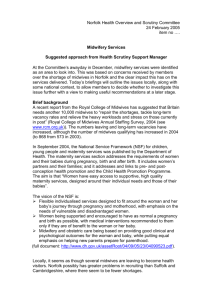
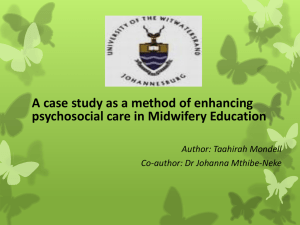
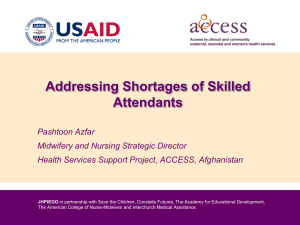
![Letter to MPs re: maternal mental health report Dear [Name of MP] I](http://s3.studylib.net/store/data/006839335_1-7d7b3127aade7ad6d126565942ce75c1-300x300.png)
